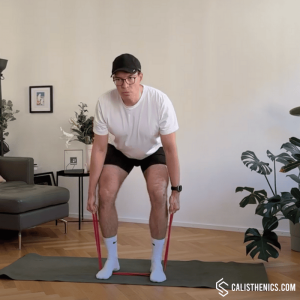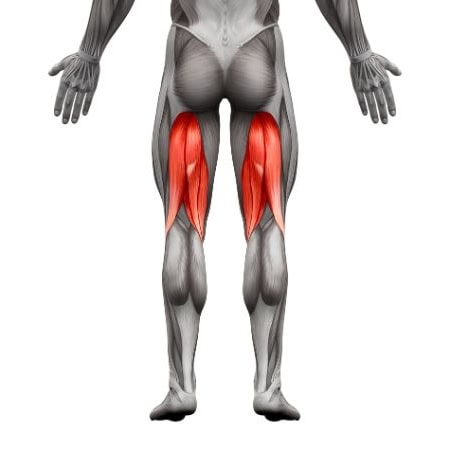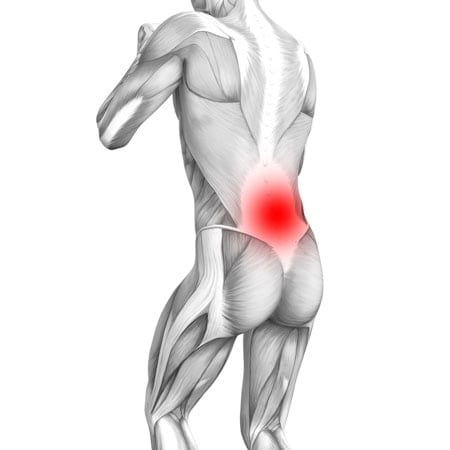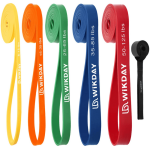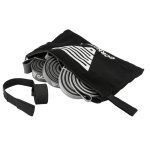Resistance Band Deadlifts
How to do Resistance Band Deadlifts?
Resistance band deadlifts are a lower-body and core exercise that mimics the movement of a traditional barbell deadlift. In this movement, the athlete steps on a resistance band with both feet and pulls up on the ends of the band, engaging the glutes, hamstrings, lower back, and core. This exercise is an effective alternative to barbell deadlifts, as the band provides variable resistance, increasing tension as you reach the top of the lift. It’s ideal for building strength, improving hip hinge mechanics, and enhancing functional movement patterns.
Steps to Perform a Proper Resistance Band Deadlift:
1. Step onto the Resistance Band:
• Stand with your feet hip-width apart on the resistance band, ensuring even tension on both sides.
• Grab the ends of the band with each hand, keeping your palms facing your legs and ensuring there is some initial tension in the band.
2. Set Up Your Position:
• Keep your feet firmly planted and slightly turned out, aligning your knees with your toes.
• Engage your core, keep your chest lifted, and pull your shoulders back. Your back should remain flat throughout the movement.
3. Hinge at the Hips:
• Inhale as you push your hips back, bending at the hips rather than the knees, and lowering your torso toward the ground.
• Keep a slight bend in your knees but avoid excessive bending. Maintain a straight line from head to tailbone as you hinge.
4. Pull the Band Upward:
• Exhale as you drive through your heels, extend your hips forward, and pull the band upward by straightening your body.
• Squeeze your glutes and hamstrings at the top of the movement, standing fully upright without leaning back.
5. Return to the Starting Position:
• Inhale as you slowly reverse the motion, lowering the band back down while maintaining a flat back and pushing your hips back.
• Stop just before the band loses tension, keeping continuous engagement in your glutes and hamstrings.
6. Repeat the Movement:
• Perform the desired number of repetitions, focusing on smooth, controlled movements and proper alignment throughout each rep.
Benefits of Resistance Band Deadlifts vs. Barbell Deadlifts
• Variable Resistance: Bands offer progressive resistance, which increases as you pull higher. This differs from barbells, where resistance is constant, challenging the muscles at all phases of the movement and adding intensity at the top.
• Joint-Friendly: The smooth resistance of bands reduces impact on the joints, which is beneficial for those with joint sensitivities or recovering from injury.
• Improved Hip Hinge Mechanics: Bands offer consistent feedback, making it easier to learn and practice proper hip hinge form without relying on heavy weights.
• Core Engagement: The increased need for balance and control in banded deadlifts engages the core and improves overall stability.
• Convenience and Portability: Bands are portable, lightweight, and don’t require a dedicated workout space, making banded deadlifts easy to do at home or while traveling.
• Reduced Risk of Injury: Resistance bands encourage controlled, smooth movement, lowering the risk of injury due to poor form or momentum.
• Versatile Intensity Options: Resistance bands come in different tensions and can be adjusted by changing foot positioning, allowing for easy modifications in intensity without needing multiple weight plates.
Common Mistakes to Avoid
• Rounding the Lower Back: Avoid rounding your lower back as you hinge. Focus on keeping your core engaged and your spine neutral throughout the movement.
• Bending the Knees Too Much: Remember, this is a hip hinge exercise, not a squat. Avoid excessive knee bending, and focus on pushing your hips back.
• Using Momentum: Perform the movement with control rather than using momentum to pull up. Controlled movements engage the muscles effectively and reduce injury risk.
• Overextending at the Top: Avoid leaning back at the top of the movement, which can strain your lower back. Stand tall and engage your glutes without arching your back.
• Losing Band Tension: Keep constant tension in the band by stopping just before full extension at the bottom. Avoid letting the band go slack, which reduces muscle engagement.
Tips for the proper execution of Resistance Band Deadlifts
Engage the Core: Keep your core tight to stabilize your spine and prevent your lower back from arching.
Focus on Hip Hinge: Ensure that the movement is driven by your hips, not your knees, to properly engage the posterior chain.
Controlled Movements: Perform the movement slowly and with control, especially when returning to the starting position, to maximize muscle engagement.
Maintain a Neutral Spine: Avoid rounding your back; keep your chest lifted, shoulders back, and your spine in a straight line from head to tailbone.
Breathing: Exhale as you pull up and inhale as you lower the band back down, helping maintain stability and rhythm.
Muscles worked when doing Resistance Band Deadlifts
Primary Muscles:
•Glutes: The gluteus maximus is heavily engaged during hip extension, especially as you stand up from the bottom position.
•Hamstrings: The hamstrings work to control the hip hinge and assist in extending the hips.
•Lower Back: The erector spinae muscles help maintain spinal alignment and support the lower back throughout the movement.
Secondary Muscles:
•Core: The abdominals and obliques engage to stabilize the torso and protect the spine.
•Quadriceps: The front of the thighs assist in stabilizing the knees and hips, especially at the beginning and end of the movement.
•Forearms: Help maintain grip on the band as you lift.
•Upper Back: The trapezius and rhomboids engage to maintain proper shoulder positioning and prevent rounding.
Primary Muscle(s):
Secondary Muscle(s):
Adjust the difficulty of Resistance Band Deadlifts
How to make Resistance Band Deadlifts harder?
How to make Resistance Band Deadlifts easier?
How to make Resistance Band Deadlifts harder?
To make Resistance Band Deadlifts harder:
-
Use a Heavier Resistance Band: Increase the difficulty by using a band with more resistance, challenging your glutes, hamstrings, and lower back.
-
Increase Range of Motion: Stand on an elevated platform (such as a low step) to increase the range of motion and tension in the band at the bottom of the movement.
-
Slow Down the Eccentric Phase: Take extra time lowering the band to the starting position, increasing muscle engagement during the eccentric (lengthening) phase.
-
Add a Pause at the Top: Pause at the top of the lift for 2-3 seconds, squeezing your glutes to increase time under tension.
How to make Resistance Band Deadlifts easier?
To make Resistance Band Deadlifts easier:
-
Use a Lighter Resistance Band: Start with a band that provides less resistance to make the movement more manageable and allow for better form.
-
Limit Range of Motion: Instead of hinging all the way down, perform partial deadlifts by hinging halfway to reduce intensity.
-
Perform Fewer Repetitions: Start with fewer repetitions (e.g., 8-10) and gradually increase as you build strength and endurance.

